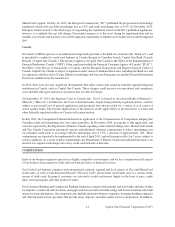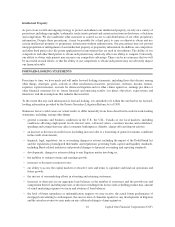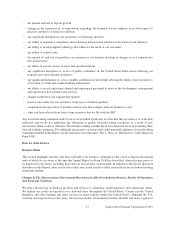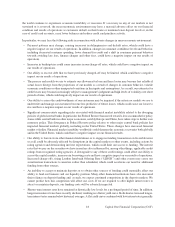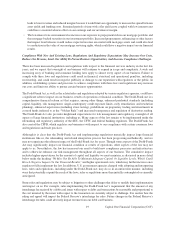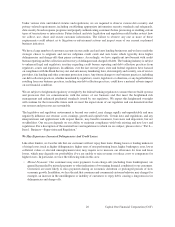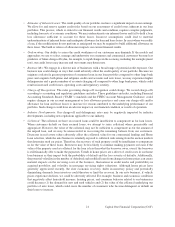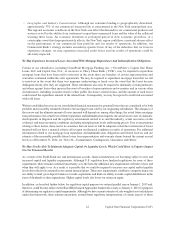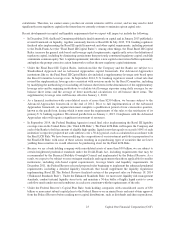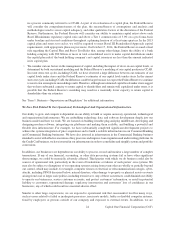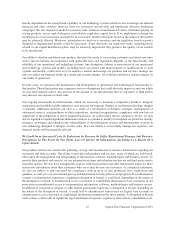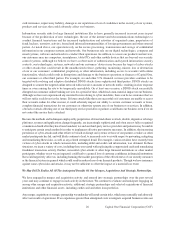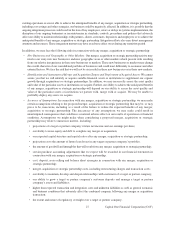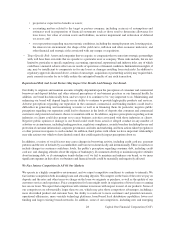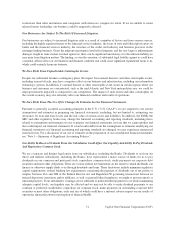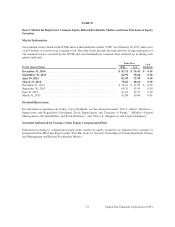Capital One 2014 Annual Report Download - page 45
Download and view the complete annual report
Please find page 45 of the 2014 Capital One annual report below. You can navigate through the pages in the report by either clicking on the pages listed below, or by using the keyword search tool below to find specific information within the annual report.calculations. Therefore, we cannot assure you that our current estimates will be correct, and we may need to hold
significantly more regulatory capital in the future than we currently estimate to maintain a given capital ratio.
Recent developments in capital and liquidity requirements that we expect will impact us include the following:
• In December 2010, the Basel Committee published a final framework on capital and in January 2013 published a
revised framework on liquidity, together commonly known as Basel III. In July 2013, U.S. banking regulators
finalized rules implementing the Basel III capital framework and other capital requirements, including pursuant
to the Dodd-Frank Act (the “Final Basel III Capital Rules”). Among other things, the Final Basel III Capital
Rules: increase the general risk-based and leverage capital requirements; significantly revise the definition of
regulatory capital, including by eliminating certain items that previously constituted regulatory capital; establish
a minimum common equity Tier 1 capital requirement; introduce a new capital conservation buffer requirement;
and update the prompt corrective action framework to reflect the new regulatory capital minimums.
• Under the Final Basel III Capital Rules, institutions like the Company and the Banks are subject to a
Standardized Approach and an Advanced Approaches capital framework. For Advanced Approaches
institutions like us, the Final Basel III Capital Rules also included a supplementary leverage ratio based upon
the Basel Committee leverage ratio. In September 2014, U.S. banking regulators issued a final rule that
revised the supplementary leverage ratio consistent with revisions made by the Basel Committee, including
by modifying the methodology for including off-balance sheet items in the denominator of the supplementary
leverage ratio and by requiring institutions to calculate total leverage exposure using daily averages for on-
balance sheet items and the average of three month-end calculations for off-balance sheet items. The
supplementary leverage ratio will become effective January 1, 2018.
• As a financial institution with consolidated assets of more than $250 billion, we became subject to the
Advanced Approaches framework at the end of 2012. Prior to full implementation of the Advanced
Approaches framework, an organization must complete a qualification period of four consecutive quarters,
known as the parallel run, during which it must meet the requirements of the rules to the satisfaction of its
primary U.S. banking regulator. We entered parallel run on January 1, 2015. Compliance with the Advanced
Approaches rules will require a significant investment of resources.
• In September 2014, the Federal Banking Agencies issued final rules implementing the Basel III liquidity
coverage ratio in the United States (the “Final LCR Rule”). The Final LCR Rule will require the Company and
each of the Banks to hold an amount of eligible high-quality, liquid assets that equals or exceeds 100% of each
institution’s respective projected net cash outflows over a 30-day period, each as calculated in accordance with
the Final LCR Rule. We have been modifying the composition of our investment portfolio in preparation for
the Final LCR Rule, with some of these actions resulting in us purchasing types of securities that are lower
yielding than securities we would otherwise be purchasing if not for the Final LCR Rule.
• Because we are a bank holding company with consolidated assets of more than $50 billion, we are subject to
certain heightened prudential standards under the Dodd-Frank Act, including requirements that may be
recommended by the Financial Stability Oversight Council and implemented by the Federal Reserve. As a
result, we expect to be subject to more stringent standards and requirements than those applicable for smaller
institutions, including risk-based capital requirements, leverage limits and liquidity requirements. In
December 2011, the Federal Reserve released proposed rules beginning to implement the enhanced prudential
requirements, including a detailed liquidity framework that would supplement the liquidity regulations
implementing Basel III. The Federal Reserve finalized certain of the proposed rules on February 18, 2014
(“Enhanced Standards Rule”). Under the Enhanced Standards Rule, we must meet liquidity risk management
standards, conduct internal liquidity stress tests, and maintain a 30-day buffer of highly liquid assets to cover
cash-flow needs under stressed conditions, in each case consistent with the requirements of the rule.
• Under the Federal Reserve’s Capital Plan Rule, bank holding companies with consolidated assets of $50
billion or more must submit capital plans to the Federal Reserve on an annual basis and must obtain approval
from the Federal Reserve before making most capital distributions, such as dividends and share repurchases,
23 Capital One Financial Corporation (COF)



